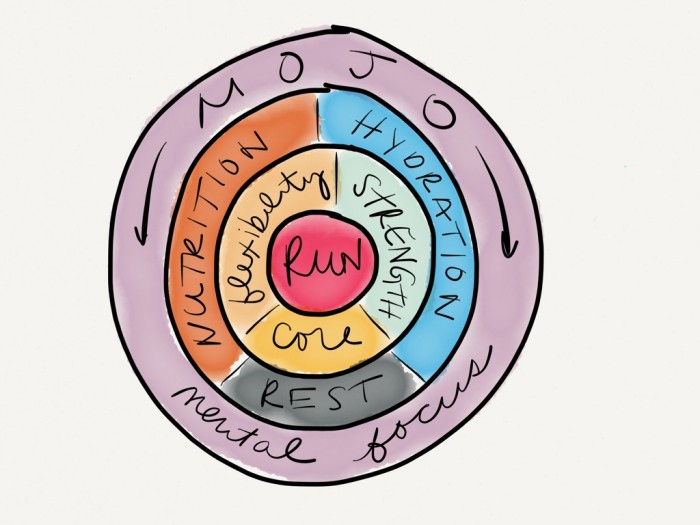Four more weeks!
This week in my countdown to Berlin, I’ll share a little about how I add some strength and flexibility work to my Circle of Running. And let me preface this by saying that it’s not much. These are both areas on which I could spend more time and focus and, if I did, it would probably make me a better runner. But there is only so much time in the day and when it comes to making time for exercise, running is the priority now.
That said, there are a few activities I include in my routine to work on strength and flexibility, because they are important. I’ll also add that I’m not a personal trainer or other professional who really knows what they’re doing. These are just a few little things that I can fit into my schedule and that I feel make a difference to me.
Strength
I’m not a gym person. I hate the gym. Been there, done that. My days of having a gym membership are over. This is why I love running, it gives me the freedom to exercise on my terms, on my schedule. And, thankfully, as I’ve experimented with many different exercise routines over the years, I’ve learned that you don’t need lots of fancy machines at the gym to work on the kind of strength you need for running.
Instead, my strength training routine has been heavily influenced by Eric Orton and The Cool Impossible. I read this book a few months ago and completely buy in to his concept of equilibrium.
Strength training is about muscle equilibrium – about making sure that the big, prime-mover muscles in the body don’t overwhelm the smaller supporting muscles, pulling the entire system out of balance and compromising efficiency. It’s more important how well we move and how efficient we are in using our strength than how much weight we can toss around…..Equilibrium promotes movement, stability, endurance, and power.
So I work on building both the big and small muscles in my legs and especially my feet. At least twice a week my workout routine includes dynamic strength exercises like strides (sometimes barefoot), uphill sprints, squats, skipping, high knees, or jumping in place.
And then there is the “storking.” My family thinks I’m a little crazy as they see me randomly standing on one foot throughout the day. “What the hell are you doing?” they ask. “Building my foot strength,” I say! These days pretty much any time I find myself standing around, I take it as an opportunity to stork. In the shower, the queue at the grocery store, cooking, pretty much anywhere. When working from home, I rarely sit and instead have my laptop at my standing desk (aka kitchen counter) allowing me to stork while I work.
In addition to my leg and foot work, about 2-3 times a week I also do stability ball exercises and planks to work on my core. After three abdominal surgeries, my core strength is basically non-existent. Realistically, I should probably do some core work every day as the gap between strong core muscles and mine is about the size of the Grand Canyon.
Flexibility
Even in my youth I was never really flexible. I remember trying out for the cheerleading squad at age 16, strategically using my skirt to fake the successful execution of the splits just long enough to tick the required box. (And hoping I’d never have to put this in practice if I made the squad.) Twenty plus years of a desk job have not improved this situation. So even if I weren’t running, this ageing, sitting at a desk, or commuting body could benefit from some regular stretching.
With regular running though, it’s even more important to incorporate flexibility work into my routine. Running is a repetitive exercise and the same muscles are constantly contracting, shortening, and prone to overuse and injury. How do I bring my muscles back into equilibrium? Simply, yoga.
My yoga practice is still in what I’d consider very early days, I’ve only been practicing for about six months. Like many runners, I started yoga in response to injury, I was trying to fix things that were wrong. But now I believe this is the most important activity that I’ve added to my routine. After a hard run (or a long commute) my muscles ache for some time on the mat, stretching and breathing the stress away. Yoga is key to improving my longevity not just as a runner but as a human.
As Christine Felstead writes in Yoga for Runners (highly recommended):
Yoga restores the balance and symmetry to the body, making it the perfect complement to running. Runners are often drawn to yoga to deal with specific issues, such as improving flexibility or helping with an injury. Yet many are shocked at the world it opens up for them, specifically the strengthening capacity and the use of muscles they never knew they had.
Yes, that’s me.
I now have a 15-20 minute yoga routine that I complete religiously after every run. This routine is focused on flexibility and stretching out those running muscles like tight hamstrings and hips. In addition, at least once a week I have a longer more balanced session that includes not just flexibility but also poses that work on strength and balance. (Really, yoga is part of my strength training regimen as well.)
A couple of things that have helped start my yoga practice:
Yoga for Runners workshop with Emma Spencer-Goodier – I attended one of Emma’s workshops earlier in the year and it was fantastic. It helped me understand the fundamentals of a good yoga practice as well as key poses important for runners.
Yoga Studio App – Love this app. It gives me the freedom to practice my yoga routine anytime, anywhere. It’s also infinitely flexible and the quality of the videos and instruction is superb, best yoga app I’ve tried. And I love how at the end of every class it reminds me to “Bring that lovely after yoga feeling into the rest of your day.”
Next week, the hardest part of my routine, trying to eat right.
+++++
Shantaram Countdown: 18 hours 14 minutes






